January 13, 2020
 by Abhishek Agrawal / January 13, 2020
by Abhishek Agrawal / January 13, 2020

In a world of instant gratification, your customers expect immediate responses to their queries.
The ability to deliver an outstanding, quick, and unique customer experience is vital for customer retention. It positively impacts customer acquisition and is the key differentiator for brands.
A PWC study found that 80% of US shoppers rate speed, convenience, efficiency, and friendly staff as important parts of customer support. Almost half of the respondents said they don’t mind paying more for greater convenience and for a user-friendly experience.
If you’re overlooking the creation of a better experience for your users, you’re doing it wrong. All the systems need to be seamlessly integrated for smooth customer experience and interactions.
Thankfully, using automation you can eliminate manual processes that are time-consuming and prone to errors. At the same time, automation allows you to gather data about the customer that you can use to deliver a better quality service. This kind of experience is responsive and personalized.
Remember, using technology to facilitate the customer experience is not meant to remove human interaction completely. With this in mind, let's dive into four automation strategies that winning companies get right!
Sales teams spend two-thirds of their time in non-revenue generation activities, leaving them with a mere 30% of the time for active selling. The remaining time is spent in internal meetings, sales-related emails, data-entry, and navigating tools.
That’s where sales automation comes to their rescue. It empowers the sales reps by using software to automate manual and repetitive tasks, thereby freeing their time to focus on prospecting, nurturing leads and building better customer experience.
A sales CRM (customer relationship management) tool helps sales teams automate logging prospect activity and details, rep outreach, and prospect and customer data. Some activities that a sales CRM automates for reps are: prospecting, lead management, email automation, and sales tracking.
|
TIP: Read user reviews to learn how CRM software can help your sales team with saving time and increasing engagement among leads. |
With office workers receiving an average of 125 emails daily, it has become more difficult than ever to new customers. Furthermore, it takes more than 18 calls to get a response from the prospect. How will your sales teams attract the attention of the audience? This is where sales intelligence becomes vital to gather the information of your target’s job title, contact, recent social media activity, company details, and milestones.
Using this information, your sales teams can send personalized messages to companies and people who fit into the buyer persona. LinkedIn Sales Navigator sends you email alerts of prequalified lists of prospects every day, week or month.
Lead management allows you to record the interactions between your sales reps and prospects and customers. They include interactions over emails, calls, social media or in-person.
You can record information such as “ABC visited the checkout page but did not make the payment”. Accordingly, you can set a follow-up date that automatically gives you a reminder on the day of the follow-up.
Email automation allows you to send a sequence of emails to your prospects that are personalized with the contact’s name as well as with your company and contact details.
Going a step ahead, to save time, you can create email templates that you regularly send to prospects. To measure the effectiveness of the emails, track the open and click rate to find interested leads and customers.
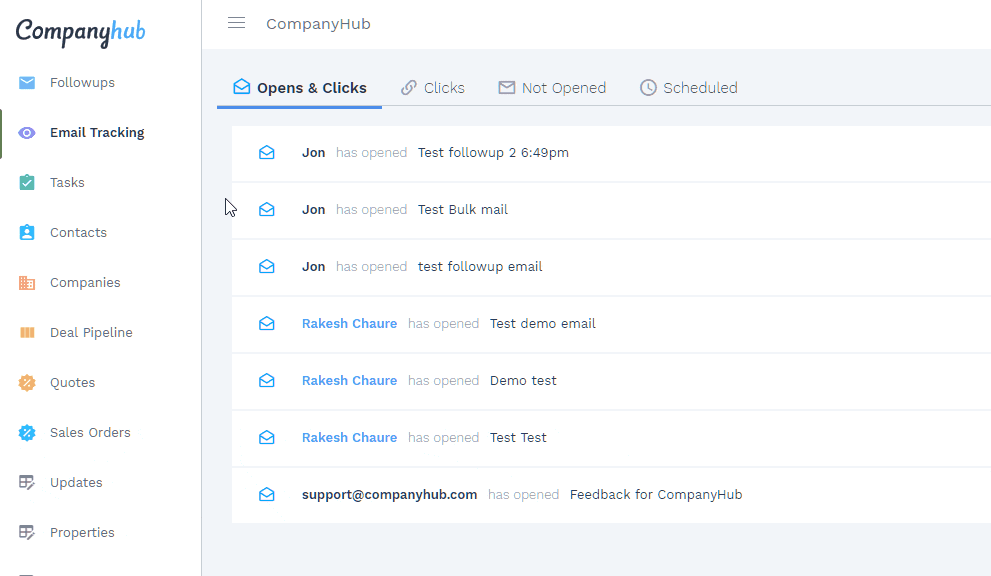
Instead of spending hours creating sales reports and workflows, the sales CRM curates data and creates a dashboard that has deal sizes, close rates, activities and comparative performance. This way, the entire sales pipeline is visualized in the form of reports.
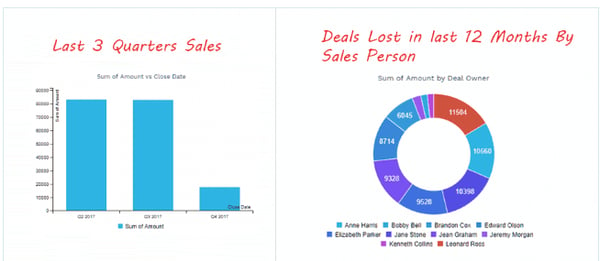
With sales automation, you can supercharge your sales reps’ productivity by freeing up their selling time. And a CRM helps you map and define the sales goals and ensure that everyone in the team is aligned to them.
Marketing automation – when done correctly – increases leads, conversions, and revenue. These tools help deliver personalized experiences to users at all touchpoints.
In order to automate your marketing, you need to understand the stage at which your audience is in the decision-making process. Marketing teams can build drip campaigns for each audience segment.
A strong drip campaign contains the following:
| A segmented email list | a list segmented according to behavior on your website, interactions with your brand, and customer data |
| Unique content | and relevant offers for each of the groups |
| A sequential email series | at this stage, you could explain your product features that solve pain points and push them to make a purchase |
| Engagement tracking | tracking of open rates, bounce rates, leads, and conversions to measure the performance of your campaign |
| Identifying repeat customers | use data to identify customers who make repeat purchases and regularly download or share your content |
Use these campaigns to turn existing customers into brand ambassadors. Here are some examples of how companies are using marketing automation.
Used not just during the sales process, welcome emails are a powerful way to engage customers after they make the purchase. As soon as the customer registers for your business, you can welcome them and share useful information. Over multiple emails, you can educate them about your product and share ways to use it. You can use a welcome campaign to ask the new customer to subscribe for your newsletter. You can let the customer know what to expect as well as the frequency of the communication.
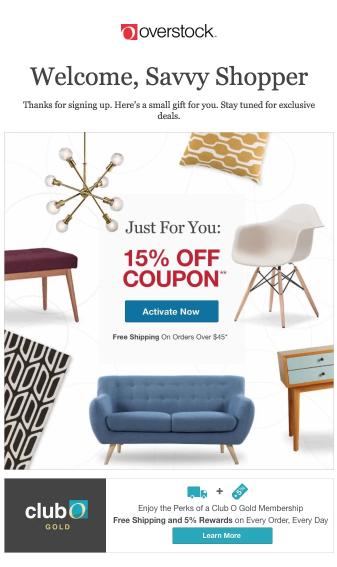
For instance, Overstock offers an incentive of 15% off and free shipping when a user signs up. Do not overwhelm the recipient by bombarding them with a deluge of emails. The best welcome emails have a call to action or nudge the viewer to undertake a task.
To leverage the fear of missing out (FOMO), automated emails can be sent to customers with a limited-time sale or offer. Two ways to create urgency are by adding a countdown timer or listing out the number of spots available for a webinar or seminar in the email.
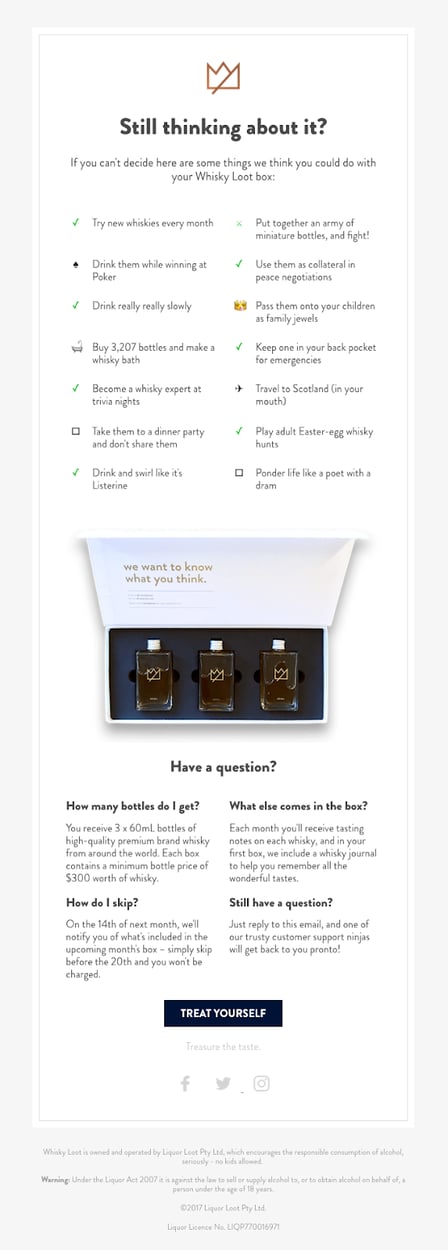
You can use analytics to see subscribers who have not opened your emails. You can set the frequency to entice customers with exclusive offers so that they would make the purchase, as soon as possible.
If your customer hasn’t visited your website or made a sale recently, you can send them emails with discount coupons. You can add product recommendations based on their previous purchases or the top-trending items worth trying to pique their interest again.

This email by Blue Apron pushes the existing customers to re-engage with a $30 discount.
Chatbots and live chat reduce the wait times for the customer, thereby increasing convenience by giving them a reply in real-time. When live chat agents aren’t around, chatbots can answer basic customer queries and guide them through the buying process.
In combination with live chat, chatbots free up your support team’s time so that they can focus on more complex issues that require human support and a personalized touch. Here’s how you can develop meaningful customer relationships by automating customer support.
Use chatbots for lead generation and presenting the visitor with the most relevant lead magnet. Based on browsing behavior, proper offerings can be suggested.

Chatbots improve customer satisfaction by providing answers to FAQs, thereby reducing the wait time. In addition, chatbots can assist with gathering site visitors’ information and using conversational selling to make a product recommendation. Lastly, chatbots can be integrated with CRMs and other systems to provide real-time data such as stock available or shipment tracking.
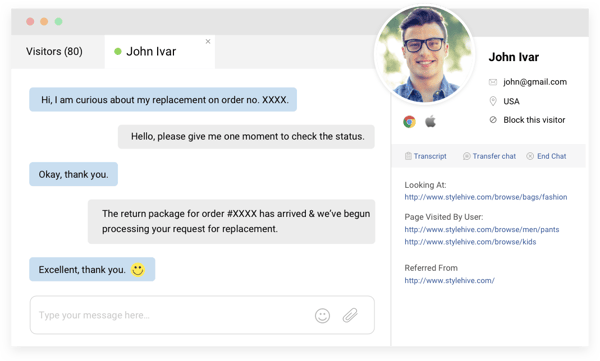
To handle queries that are repetitive and do not require human intervention, chatbots are a powerful automation tool. Additionally, they can engage with customers throughout the day, even at times when your support staff is not present online.
|
TIP: Discover top-rated chatbot software on G2 and find the right solution to help with your customer support needs. |
Are you leveraging data to understand customer expectations to improve your overall customer experience? The key benefit of automation is that it helps you make sense of your customer data by turning information into actionable insights. These informed decisions will improve experience across all channels.
With customer interactions becoming more public, customer care over social media is considered new age-marketing. In fact, customer care teams are 10 times more likely to resolve customer queries over social media than they were two years ago. This indicates that what was new and atypical in 2016 or 2017 is not the same today.
Here are some ways to gather and infer data from various automation tools:
According to Moosend, 63% of companies that use marketing automation outperform their competitors. Using automation can help your brand bridge the gap between internal and external workflows and processes. By improving the customer’s experience with your brand, you can transform your brand into a customer-centric company.
Automation performs repetitive tasks and interactions, thereby enabling your team to focus on building long-term relationships with your customers. While using automation, preserve the human touch in sales, purchase, and support journey. Doing so will facilitate conversions and ROI for your business.
Make your automation personalized by using personalization software. Find the solution for your needs on G2.
Abhishek Agrawal is the Founder of CompanyHub, an intelligence CRM for sales teams.
Purchasing and onboarding new software costs a lot. A good software deal helps decide who from...
.png) by Shreya Mattoo
by Shreya Mattoo
Black Friday is almost here, with a once-a-year chance to snag premium software at a fraction...
 by Washija Kazim
by Washija Kazim
Black Friday might dominate the headlines, but savvy software buyers know the real deal — ...
 by Washija Kazim
by Washija Kazim
Purchasing and onboarding new software costs a lot. A good software deal helps decide who from...
.png) by Shreya Mattoo
by Shreya Mattoo
Black Friday is almost here, with a once-a-year chance to snag premium software at a fraction...
 by Washija Kazim
by Washija Kazim


